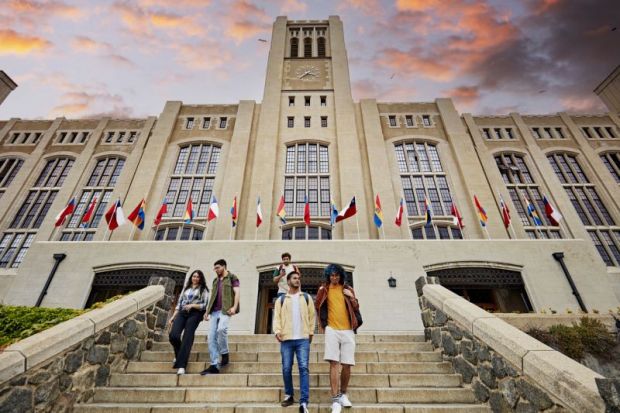View the THE Latin America University Rankings 2023 results
Chilean universities are on track to become the most internationally outward-looking institutions in the Latin American region, Times Higher Education’s latest ranking suggests.
The country’s average score for international outlook has consistently risen since 2019 to reach 70 in the THE Latin America University Rankings 2023. Chile is second in the region on this measure, when only considering countries with at least four ranked universities, but is poised to overtake Ecuador, which despite its score of 71.6 has seen a downward trend compared with four years ago.
Chile’s 32 ranked universities and Ecuador’s 14 beat the regional average by a long shot in this pillar, which is a measure of the proportion of international students, international staff and cross-border research collaborations. The average international outlook score for all countries in the Latin America University Rankings 2023, which is topped by Pontificia Universidad Católica de Chile for the fifth consecutive year, is 47.
The two countries also score highly in the citations pillar, with 67.5 for Chile and 51.3 for Ecuador – first and third place in the region, respectively. Argentina is second with 58.3. Previous studies have shown that there is a strong positive correlation between internationally co-authored research and citation impact.
Talking leadership: Jorge Grünberg on creating entrepreneurs
While Chile’s universities are becoming increasingly outward-looking, the nation is less dominant in the table overall, slipping down to third when measured on the number of ranked institutions. It is overtaken by Colombia, which now has 36 ranked institutions, up from 29 last year. Brazil continues its streak of being the most-represented nation, with 65 institutions.
However, with high average scores of 70 and above, it is Chile and Ecuador’s performance in internationalisation that stands out in these rankings. The contrasting trends – one nation rising, the other falling – also point to realities in the continent, where the health of higher education can sway with the powerful forces of political leadership and funding budgets, according to experts.
These trends are mainly driven by the countries’ performances for international research collaboration; when considering universities that have been continuously ranked since 2019, Ecuador’s score in this indicator has dropped from 96.6 four years ago to 83.4 in the latest ranking. Meanwhile Chile has climbed, from 75.7 in 2019 to 82.0 this year.
The share of foreign faculty remains high for both nations, relative to the region as a whole. Looking at the raw data, this percentage grew from 6.5 per cent to 7.6 per cent in Chile, but Ecuador saw only a slight increase (by 0.4 percentage points) over the past four years. Regarding international students, both countries had a share of 2 per cent in the 2019 league table. This has dropped to 1.4 per cent in Ecuador in this year’s ranking and risen only slightly in Chile (to 2.1 per cent).
THE Latin America University Rankings 2023: the top 10
| Latin America rank 2023 | Institution | Country/region | Overall score |
| 1 | Pontificia Universidad Católica de Chile | Chile | 90.3 |
| 2 | University of São Paulo | Brazil | 88.3 |
| 3 | University of Campinas | Brazil | 87.0 |
| 4 | Monterrey Institute of Technology | Mexico | 84.7 |
| 5 | Universidade Federal de São Paulo (UNIFESP) | Brazil | 84.5 |
| 6 | Universidade Federal do Rio Grande do Sul | Brazil | 83.1 |
| 7 | Federal University of Minas Gerais | Brazil | 82.5 |
| 8 | Pontifical Catholic University of Rio de Janeiro (PUC-Rio) | Brazil | 81.9 |
| 9 | University of Chile | Chile | 81.6 |
| 10 | Universidade Estadual Paulista (Unesp) | Brazil | 81.1 |
Alicia Salomone, director of the international relations office at the University of Chile, explains that key to the internationalisation of Chile’s three leading universities is a funding boost from the government that kicked in in 2016. She estimates that the three institutions have received a total of $13 million (£10 million) in three or four cycles, earmarked for projects towards internationalisation.
Salomone speaks to THE from Stockholm, where she is meeting with a steering group on academic partnerships between Chile and Sweden. Referring to the event and other recent strides in internationalisation, she says “none of it would be possible” without the pot of money from the state.
“It's not a huge amount of money. But it's a very important amount of money for Latin American universities,” she says, adding that such work cannot be sustained by revenue from student fees. The funding has been used to establish joint PhD programmes with universities outside Latin America, such as the joint PhD in mechanical engineering between the University of Chile and the UK’s University of Manchester.
Public universities in Chile, unlike their counterparts in Brazil, Argentina, Uruguay and Ecuador, do not provide free university education at the undergraduate level – although it is a topic that is being hotly debated. Salomone thinks that this “puts limits” on their ability to attract undergraduate students from other Latin American countries.
Postgraduate and PhD programmes have therefore become the main draw for foreign students. According to data from the University of Chile, as of 2022, the proportion of international PhD students was eight times that at the undergraduate level.
“At the postgraduate level, the University of Chile is an option for many students that don’t have the opportunity or are not willing to go to Europe or to the US. Moreover, as we provide the possibility of a jointly awarded degree, especially at the PhD level, they can have both.”
While the government funding helped set in motion promising initiatives, there are concerns about what will happen when the money dries out next year.
“The sustainability of the internationalisation project is the main challenge,” says Salomone.
The pressure is on for Chile’s top universities to “create the conditions to continue this process [of internationalisation] without external financing”, she adds.
Higher education performance in the region can be affected by government in different ways. If Chile’s rise is linked to funding, Ecuador’s fall may be connected to the politics of education.
Amanda Johnson, director of the Gerald H. Read Center for International and Intercultural Education at Kent State University in the US, says that Ecuador saw a push towards the internationalisation of higher education during the presidency of Rafael Correa from 2007 to 2017.
“He really did see higher education as a sort of driver for the development of the country to impel it into the global knowledge economy,” says Johnson, who has worked in universities in Ecuador and researched the region.
The former president’s motivation may have been shaped by his PhD experience in the US, she suggests, adding that his efforts were less like a coordinated strategy and more like wind in the sails.
During his decade-long term, public spending on higher education rose from 0.7 per cent to 2.1 per cent of GDP. In 2017, at the end of his presidency, a report from the US-based Center for Economic and Policy Research said this was the “highest level of government spending on higher education in Latin America, and higher than the average of the OECD countries”.
Johnson also refers to a scheme called the Prometeo Programme, which brought almost a thousand international scholars into Ecuador to “do research and to bring in fresh ideas into the institutions”. However, the initiative ended with Correa’s presidency. Critics have argued that many of his policies and initiatives, including those in higher education, could no longer be sustained after the once-booming oil industry declined.
Correa’s left-leaning government focused on the nationalisation of higher education; governments since have been more bent on privatisation. What does this political pendulum mean for the sector?
“Privatisation puts more power in the hands of the institution or organisation and less in the hands of the government. So, depending on where you stand, it could be seen as good or bad,” says Johnson.
But the decline of internationalisation in Ecuador, as shown in the THE rankings, reveals the fragility of Ecuador’s higher education sector.
“For a lot of Latin American countries, higher education is a political tool. It’s very much vulnerable to politics,” says Johnson.
Beyond the factors of politics and economics, Gustavo E. Fischman, professor of educational policy and comparative education at Arizona State University, suggests another aspect at play: language.
In recent years, Latin America’s Spanish- and Portuguese-speaking nations have been incentivised to drive up publication in international journals – usually in English.
However, local students cannot follow this research, says Fischman, who spends his time between the US and Brazil.
“When you publish research, what you want is to contribute new knowledge. But also, to use it to educate other generations. If what you’re doing is outside the understanding of your students…we have a problem that is serious,” he believes.
However, Chile’s Salomone says that without the use of foreign languages, internationalisation is “not realistic” for Latin America.
“Foreign language is not a synonym for English,” she clarifies. “We need to incorporate other foreign languages.”
Meanwhile, Kent State’s Johnson has a more fundamental view of internationalisation. “It is about being able to bring the world to your campus. Is your campus a bridge to the world?”
Register to continue
Why register?
- Registration is free and only takes a moment
- Once registered, you can read 3 articles a month
- Sign up for our newsletter
Subscribe
Or subscribe for unlimited access to:
- Unlimited access to news, views, insights & reviews
- Digital editions
- Digital access to THE’s university and college rankings analysis
Already registered or a current subscriber? Login








